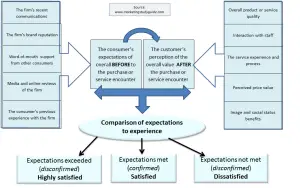Introduction to the Disconfirmation Model of Consumer Satisfaction
Essentially customer satisfaction is the consumer’s evaluation of how well the firm (usually a service firm) has lived up to their promises. As outlined in the general discussion of customer satisfaction, consumers compare their initial expectations of likely value against their perception of the actual value they received when they purchased or consumed the product or service.
Because consumers are comparing two aspects (prior expectations to actual delivery) they are essentially confirming (or disconfirming) how well the organization has delivered. In services marketing textbooks, this process is described as the Disconfirmation Model of Customer Satisfaction.
This website has a basic model for understanding the process that consumers use to generate their customer satisfaction level, which is most suitable for students in an introductory marketing course. However, below is the more detailed Disconfirmation Model of Customer Satisfaction, which is designed for review by students undertaking services marketing as a subject or as an university assignment.
The Disconfirmation Model of Customer Satisfaction

(Click to enlarge)
Inputs to Expectations of Value
The customer’s expectations have been built over time by a variety of inputs (as shown in the top left of the model), which are:
- The firm’s most recent communications (mainly advertising and promotional deals),
- The firm’s brand image (which is the aggregate of their long-term communication efforts),
- Word-of-mouth (WOM) communication from other people (possibly also including salespeople),
- External media reports, online reviews and information, and
- The customer’s previous experiences with the firm.
The organization has significant control over the first two inputs (communications and brand image) and, therefore, attempt to build strong, positive but realistic expectations of the firm and its offerings to potential customers (that is, its target market). Their effectiveness in this regard is impacted by the quality and consistency of their communications program, as well as by their total level of promotional spend and their share-of-voice relative to their direct competitors.
The next two inputs (word-of-mouth and traditional, online and social media reports) is much harder to control. Typically firms have implemented public relations programs in order to generate positive media attention. These days many firms are also active on social media platforms and also focus upon sponsorship and corporate social responsibility projects.
The last input (the customer’s previous experience) is highly relevant for existing customers. This website has a separate section discussing how existing customer’s satisfaction levels evolve over time. Clearly for most firms interested in tracking customer satisfaction levels, they would be mainly researching existing customers (as opposed to new), making previous experiences a critical factor. (However, the need to measure the satisfaction levels of both new and existing customers is also discussed in the section on how to track customer satisfaction levels.)
In total, these five main inputs will create and shape each consumer’s level of expectations of value from the firm. Expectations of each consumer will generally vary to some extent, based on their individual exposures to the various communications, their level of purchase involvement, and their previous experiences.
Influences on the Perception of Delivered Value
As shown in the top right of the model, there are multiple influences upon how the customer perceives the level of value received, which are:
- Overall product/service quality (that is, how well it worked, how easy was it, enjoyment, benefits received, and so on),
- Interaction and relationships with staff,
- The service experience and process,
- Perceived value for money, and
- Perceived image and social status received (that is, was the customer’s self-esteem enhanced by becoming a customer of the firm – an example here would be becoming a customer of a private bank).
Like the inputs to expectations, these factors then work in aggregate to form the customers overall perception of value received. Again, because this is based upon perception, each customer is likely to form a slightly different view based upon their own experiences and what aspects of the product/service is most important to them.
Confirmation or Disconfirmation?
The balance of the model is the evaluation stage, such as the post-purchase phase of the buyer decision process in consumer behavior topics. The customer will assess how well the purchase experience lived up to their prior expectation. Depending upon the level of purchase involvement, this evaluation process made be simple or quite complex, as outlined in the following table.
Level of Purchase Involvement | Examples | Likely Extent of Evaluation |
Low | Coffee shop, movie, bus travel | Quick, reflex thought, but not overly concerned |
Medium | New clothes, home loan, doctor visit, airline travel, hotel, restaurant | Some consideration given, possibly will comment to other people |
High | Own wedding, important legal advice, choice of university | Significant thought and analysis, may refer back to initial information, likely to review the product and experience aspects in detail, likely to discuss with other people |
Scale of Customer Satisfaction
Depending upon whether the customer’s expectations have been met (that is, confirmed) or exceeded (positively disconfirmed) or not met (negatively disconfirmed) will determine the customer’s overall satisfaction level – as represented by the three boxes at the bottom of the model.
But keep in mind that the customer’s satisfaction level can sit anywhere along a scale, not simply in a box, as highlighted in the following diagram.

(Click to enlarge)
Please note that information on measuring and tracking customer satisfaction is discussed in more detail in another section of this website.
